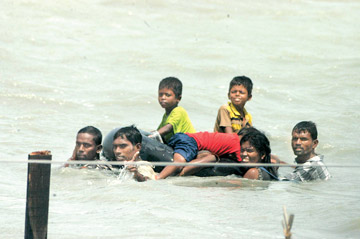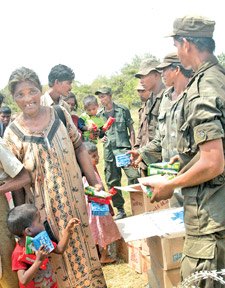Great humanitarian mission
A medical officer's perspective:
By Dhaneshi YATAWARA
It was nearly two years ago that brave men of Sri Lankan Forces made
this island nation free from terrorism and its skeletal remains.
 In
the raging battle between life and death, the human rescue mission
carried out by the Forces could be a unique feat in the annals of
military history. The great victory once roundly praised by the world
now faces a debacle with an uncertain future. In
the raging battle between life and death, the human rescue mission
carried out by the Forces could be a unique feat in the annals of
military history. The great victory once roundly praised by the world
now faces a debacle with an uncertain future.
Rescuing innocent civilians from the iron grip of the Tigers is not
just bringing them to the other side of the land or making safe passages
for them to escape. Vehicles to transport them needed to be arranged.
Huge quantities of food had to be provided for them in addition to the
responsible task of feeding thousands of officers and soldiers of the
Army.
Considerable resources were essential and a continuous supply chain
had to be maintained. All these happened while intense fighting
continued in the Forward Defence Lines which heavily demanded arms and
ammunition, food, water, medicine, casualty evacuation etc.
In a backdrop where battalions of allegations on a humanitarian
mission are made against a sovereign state, taking the entire world back
on the time tunnel could be ideal yet impossible. But for those who-eye
witnessed chapter by chapter the entire episode of the past, remains
more alive than the present.
To Dr. Vijith Gunasekara, service at the Pulmoddai ad-hoc health
centre in 2009 during the height of the war was a unique experience that
made a turning point in his career. Our job responsibility was to give
proper medical care for the patients who were ferried to safety from the
North and the East, said Dr. Gunasekara as he started relating his
experience. By around end February 2009 sick and injured stranded in the
No Fire Zone were transferred to proper medical facilities established
at Pulmoddai by the Ministry of Health. I joined the crew as the
coordinating officer of the Pulmoddai ad hoc hospital during the initial
stages where people came in large numbers for variety of medical needs.
By the time the Health Ministry asked me to take the position I was the
Deputy Director at the Lady Ridgway Hospital in Colombo," Gunasekara
said.
According to Gunesekara patients have been first brought to
Trincomalee and later transferred to the Pollonnaruwa Hospital. Since
reaching such a distance from the North takes the precious time of the
fatally ill, the Ministry of Health had plans to shift the medical
facility more closer to the North to establish a temporary hospital.
Parallel to this decision the Indian Government extended their hand to
Sri Lanka through medical support by this time assisting the
humanitarian mission. With all this the Health Ministry established a
temporary hospital with the provided assistance from the Indian medical
team. "There was one doctor before me in charge of the facility who
basically did a massive job in establishing the centre. And I took over
at a time in which a large number of Tamil civilians reached us for
medical assistance, he said.
"During the initial few weeks, every other day we receive 125 - 150
patients for treatment. This was both injured patients as well as
patients with general ailments and medical conditions such as
complicated diabetes, hypertension whom we generally categorise as
normal patients," he said. "What we had to do was triage," he explained.
Triage is the process of determining the priority of patients'
treatments based on the severity of their condition. Based on this
categorisation critical patients were sent immediately to other
hospitals according to their condition after stabilizing them with first
aid. "The medical facility at Pulmoddai was equipped with all the
medical essentials and we had a good coordination with the Indian
doctors and every case we managed successfully," he added.
"The working environment was very strange. Until five in the evening
the beach is silent with few people and when the ship with patients and
bystanders reach seas off Pulmuddai the entire set-up change," he added.
The dark coloured beach of the Pulmoddai sea starts getting busy with
lots of human activities.
The entire crowd, comprising with Navy personnel and International
Red Cross employees were getting ready to receive the sick and the
wounded rescued from the 'No Fire Zone'.
Mediated by the International Red Cross the helpless civilians are
brought to safety by the 'Green Ocean', chartered vessel. Sinhala and
Tamil fishermen from Negombo deployed by the International Red Cross,
were waiting on the beach until the vessel berthed in the seas off
Pulmoddai.
Using their small 'dinghy' boats these men safely transported the
Tamil civilians to the beach. Under rough weather conditions bringing
the sick and wounded people from the 'Green Ocean' to the shores using
small boats definitely needed much courage and grit.
"We had a fleet of 15 - 20 ambulances which were sent by hospitals
from other parts of the country on the instructions of the Ministry of
Health," the doctor said. In addition buses from Sri Lanka Transport
Board and several private owners were always available to transport
people to safety.
 The
Indian medical team of 52 personnel included consultant doctors,
doctors, nurses and assisting medical staff and everyday there were ten
Sri Lankan doctors along with a large medical staff working throughout
24 hours a day. The
Indian medical team of 52 personnel included consultant doctors,
doctors, nurses and assisting medical staff and everyday there were ten
Sri Lankan doctors along with a large medical staff working throughout
24 hours a day.
The Indian temporary hospital had a fully equipped operating theatre
and we managed a blood bank and a doctor from the blood bank was always
present, Gunesekara added.
"When the work starts around 5.30 in the evening until next day
morning the work goes on," he said. "As the doctor in charge I had to
send reports to several authorities by the end of each day," he said
further.
"Every higher official responsible contacted me everyday to find out
the situation specially the then Secretary to the Ministry Dr. Athula
Kahandaliyanage, Director General Health Services Dr. Ajith Mendis, Dr.
Wimal Jayantha," he added. Since the Displaced persons were sent to the
Welfare Villages in Vavuniya the then Competent Authority for IDP
welfare was Major General G.A. Chandrasiri was also made aware of the
number of patients.
"At times we even had to take child births and to our greatest
satisfaction every incident was a success," he said. "The main problem
was communicating," he added. For this the doctors sought the help of
villagers who volunteered to assist in this cause.
"A local NGO maintained a large kitchen that provided food for every
person who reached the land," he said.
"The entire operation was for just four months and in the latter part
the number of people from North and East declined drastically as land
areas were opened for the people to reach safely," Gunesekara added. "As
medical practitioners it was a one-of-a-kind experience one would rarely
get a chance to go through," he said with great satisfaction.
Today working as the Deputy Regional Director in Galle Dr. Gunesekara
keeps his unforgettable experience alive not only for him but to prove
the humane approach Sri Lanka had towards innocent Tamil civilians who
escaped from the iron clutches of LTTE Tigers.
He is one of those credible witnesses for a great humanitarian
mission. |

